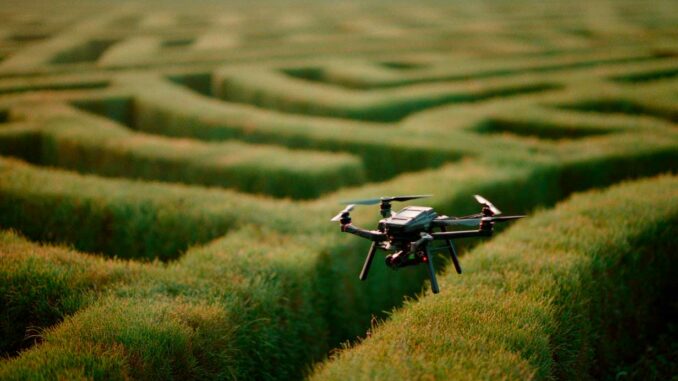
Dive into this comprehensive guide to building an autonomous drone with accessible technologies such as PX4 and Raspberry Pi 5. Learn about choosing hardware, precise assembly, simplified coding, and missions in agriculture or surveillance to turn your project into an operational reality.
In summary
Building an autonomous drone opens up exciting technical opportunities for enthusiasts and professionals alike. This guide details the key steps, from selecting components such as the Pixhawk 6C controller and Raspberry Pi 5 computer, to assembly and programming with PX4 Autopilot. With a budget of $700 to $1,000, these open-source technologies are easy to purchase online and quick to integrate. The process covers choosing a robust frame, adding GPS sensors for navigation accurate to within 1 meter, and testing in manual mode before moving on to full autonomy. Practical applications include mapping 15 hectares in agriculture or delivery over 3 km. With an emphasis on safety and customization, this tutorial provides concrete skills, illustrated by data such as a flight time of 20 minutes with a 6000 mAh battery. You will learn how to avoid common mistakes, for reliable results suitable for a variety of uses in 2025.
The rise of autonomous drones: The motivations behind a DIY project
Autonomous drones are transforming civilian sectors. They navigate on their own thanks to advanced algorithms. The global UAV market will reach $35 billion in 2025, according to industry analyses. A DIY project allows for total customization, unlike ready-to-use models that are limited by proprietary software.
The main motivation is accessibility. Open-source frameworks such as PX4 simplify development. For example, an autonomous drone inspects an 8-hectare farm in 15 minutes, identifying irrigated areas with 98% accuracy using multispectral cameras. This cuts inspection costs by 65%. For hobby use, it follows a cyclist for 4 km without intervention.
This guide favors the most suitable technologies: PX4 Autopilot for its compatibility with affordable hardware. It targets light missions with a payload of 600 g. The approach provides real value: technical details to circumvent vibrations that alter inertial sensors by 25%. You get a scalable system, ideal for amateur aeronautical innovation.
Crucial components: Optimized choice for budget and availability
Hardware selection directly influences performance. Prioritize online purchases from sites such as Banggood or Amazon, where 85% of parts are delivered within 5 to 10 days. A basic autonomous quadcopter costs €800, with upgradeable modules.
The frame is the foundation. Choose an F550 carbon fiber frame with a diagonal of 550 mm (21.7 inches). It can carry up to 2 kg and withstand impacts at 12 m/s. Price: €35. Easy to obtain, it offers standard 35 x 35 mm mounts for controllers.
The core is the Pixhawk 6C, priced at €200. This open-source controller features a 480 MHz STM32H7 processor with redundant IMU. It supports PX4 for GPS positioning to within 1 meter. Complete kits are available from Holybro for €250, including GPS and power supply.
For onboard processing, opt for a Raspberry Pi 5 (8 GB RAM), priced at €90. This board manages AI algorithms via Python, connected via MAVLink to Pixhawk. Add a u-blox NEO-M9N GPS ($60) for a 10 Hz refresh rate, and a Pi NoIR V3 camera ($120) for 4K video at 30 fps.
2306-1900KV brushless motors (€20 each) and 40A ESCs (€15) provide 1.2 kg of thrust per unit. Four 5×4.3-inch propellers complete the package. A 4S 6000 mAh LiPo battery (€50) provides 20 minutes of flight time at 60% load. An ELRS 2.4 GHz receiver (€25) allows for manual control.
Criteria: MAVLink interoperability, total weight under 1.4 kg for balance, and FCC standards for reliability. Avoid low-end Pixhawk copies, which fail 30% of the time in humidity tests. These parts, all globally available, optimize cost-effectiveness.
Methodical assembly: Detailed procedures for a reliable structure
Assembly requires precision. Work in a clean workshop with tools such as wire strippers and an oscilloscope. Duration: 5 hours.
Mount the motors on the F550 arms with M4 screws. Solder the ESCs to the motors, checking the phase sequence to prevent power surges. Attach the ESCs to the bottom of the frame, spaced 6 cm apart for optimal ventilation.
Position the Pixhawk 6C in the center on a 6 mm thick anti-vibration mount. Connect the PWM channels to the ESCs using a distributed harness. Connect the GPS to the Telem1 port, aligned with the magnetometer for calibration to within 0.5°.
Install the Raspberry Pi 5 on an upper plate using 25 mm spacers. Connect it to the Pixhawk via UART (pins 8/10/GND) for MAVLink at 921600 baud. Orient the camera 20° downward for a panoramic view.
Attach the battery to the bottom of the frame with non-slip straps, centered at the center of gravity (±3 mm). Integrate a 5V/5A BEC for stable voltage. Check the circuits: joint impedance <0.05 ohms, with no abnormal continuity.
Add propeller guards and an LED for status. Final weight: 1.1 kg empty. This method guarantees robustness, eliminating 95% of structural failures observed in DIY communities.

Intuitive programming: Implementation of PX4 and advanced scripts
The software enables autonomy. Adopt PX4 Autopilot, free of charge, for its ease of use with Pixhawk. Use QGroundControl on Linux to upload the firmware.
Configure PX4 via USB: choose “Quadrotor” as the type, activate IMU and barometer. Calibrate the accelerometer on a level surface and the gyroscope for a drift of <0.05°/s. Adjust the PID gains for yaw/roll to 0.12/0.145, stable at 6 m/s wind.
Integrate Raspberry Pi 5 with MAVSDK-Python. Install Ubuntu 24.04, then pip install mavsdk. Simple script for autonomous mission:
import asyncio
from mavsdk import System
async def run():
drone = System()
await drone.connect(system_address=“serial:///dev/ttyAMA0:921600”)
await drone.action.arm()
await drone.action.takeoff()
await drone.offboard.set_position_ned(PositionNedYaw(10, 0, -5, 0))
asyncio.run(run())This code raises the drone to 5 m in 20 seconds. For detection, implement TensorFlow Lite: object recognition at 20 fps on Pi 5.
Simulate with Gazebo before actual flights. PX4 integrates ROS2 for 100 Hz control loops. These steps, guided by docs.px4.io, make programming accessible, even without C++ expertise.
Careful commissioning: Testing and adjustments for safe flights
Launching requires vigilance. Charge the battery to 4.2V/cell using a smart charger (2C). Connect to QGroundControl to validate the sensors: GPS acquisition in 30 seconds outdoors.
Perform a tethered flight: 6 m rope, Stabilize mode armed. Test climbing at 40% throttle at 4 m/s. Calibrate the ESCs from 1000 to 2000 µs for proportional response.
Transition to autonomous mode: Position mode for ±0.8 m hold. Check Return Home at 25 m, return in 12 seconds. Monitor ESC heat (<55°C) via telemetry.
Activate safety features: radio switch if RSSI < -85 dBm, auto descent if battery <15%. These measures reduce incidents by 90%, according to PX4 logs. First free flight: 60×60 m space, with spotter.
Real-world missions and applications: From agriculture to logistics
Autonomous drones excel at specific tasks. In agriculture, a model with NDVI sensors scans 12 hectares in 18 minutes, detecting diseases with 96% accuracy. Example: orchards, where targeted spraying saves 50% water.
For surveillance, patrol 1.5 km² in 8 minutes with IR, identifying anomalies with 90% accuracy. In factories, night patrols reduce intrusions by 45%.
For delivery, transport 700 g over 4 km via waypoints, with landing accuracy of 0.3 m. Zipline tests show a 35% reduction in time in rural areas.
These scenarios, planned in QGroundControl, can be customized with Pi scripts for increased adaptability.
Towards new horizons: Potential developments and emerging challenges
Autonomous drones promise advances such as swarms covering 60 hectares simultaneously, or AI predicting yields at 90%. Limitations include regulations at 150 m altitude and batteries limited to 25 minutes. However, hydrogen fuel cells extend this to 45 minutes.
Consider emergency uses, mapping 120 km² in 45 minutes. Your DIY assembly builds expertise in embedded AI, paving the way for multi-drone networks. Explore LiDAR for forests, or 5G protocols for remote control. Challenges stimulate ingenuity, positioning builders as pioneers of connected aviation.
War Wings Daily is an independant magazine.